Early Views of Sports in LA*
*Note: This site is still under construction. For a more complete page click HERE to see Baseball in Early L.A.
Baseball
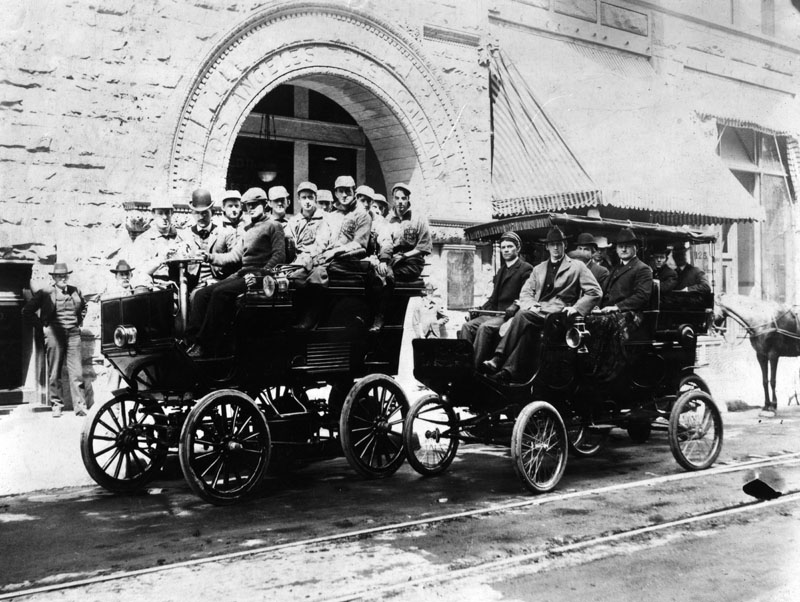 |
|
| (1902)* - Two unidentified vehicles used to transport a large number of people,"Sports" is the note on the photograph. From another copy of the subject the team is identified as the "Bank baseball team, Second Street and Spring Street, 1902." Los Angeles Trust Company, engraved in the arch of the doorway to the building in the background, may be the "Bank" referred to. |
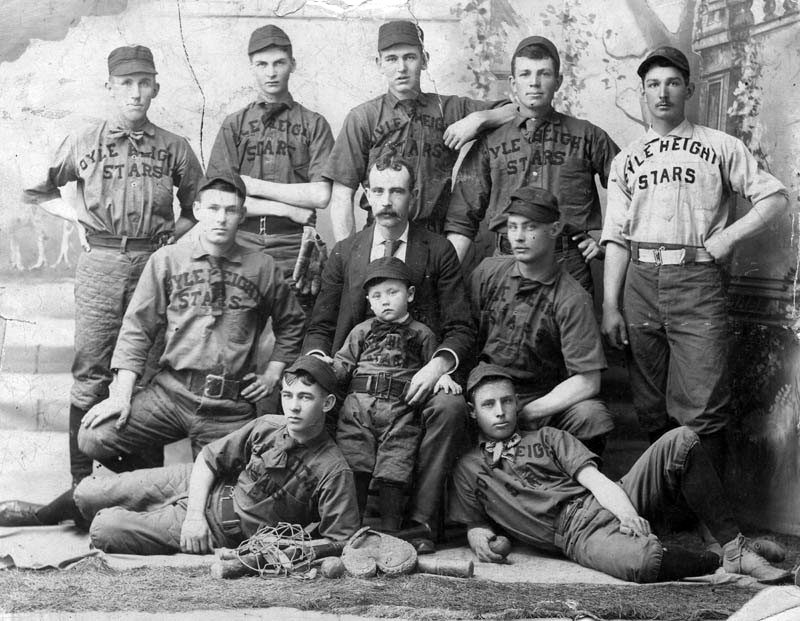 |
|
| (1925)* - Professional baseball came to Los Angeles in the early 1890s, with the Los Angeles Angels of the short-lived California League. At the turn of the 20th Century, neighborhood teams like the Boyle Height Stars flourished throughout Southern California. |
Washington Park
 |
|
| (1924)* - Aerial view of Washington Park, home of the Los Angeles Angels. The bleachers are practically bursting at the seams with eager spectators cheering on their favorite teams. Hill Street is visible on the west (parallel to 1st base line) and Washington Blvd is on the north (across the top). |
Historical Notes Washington Park was home of the Los Angeles Angels from 1912 until they moved to Wrigley Field in 1925; the park was located in downtown Los Angeles on Washington, 8th St., and Hill Street. Although Washington Park could hold up to 15,000 "kranks" - as fans at the turn of the century were called, it had very limited parking facilities. Wrigley decided to build a new ballpark, which was named Wrigley Field, and the team moved to its new home during the 1925 season. Wrigley Field housed the Angels from 1925 until 1957.*^ Prior to the Angels playing at Washington Park, they played at a field on the north end of Chutes Park, located between Grand Ave. (west), Main St. (east), Washington Blvd. (north), and 21st St. (south), just a short distance away. In the seventeen years that the Angels played at Washington Park, they won five pennants. Washington Park was demolished in the Mid-1950s.* |
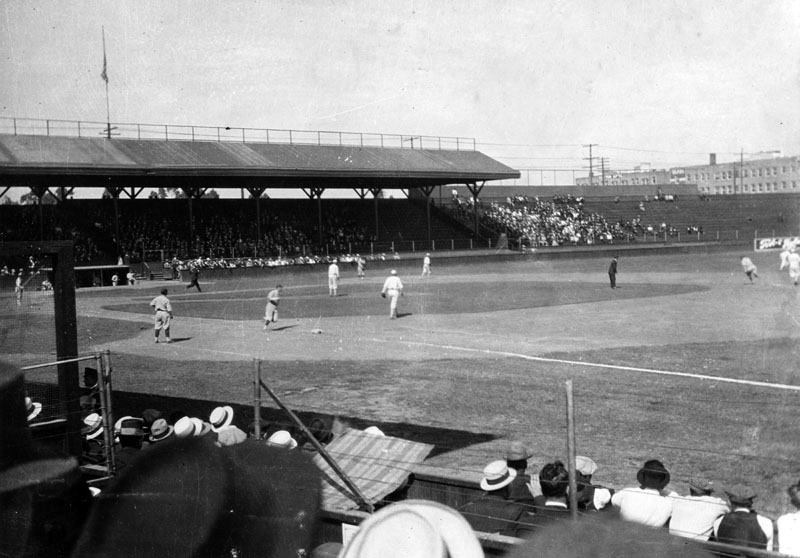 |
|
| (1917)* - The Washington Park bleachers are full with eager spectators cheering on their favorite teams. It is unknown which team is the batting team, and which is the fielding team, but may be either the Los Angeles Angels or the other home team, the Hollywood Stars. Two players are running around first and second bases, as the rest of the players look toward left field. |
Historical Notes From 1903 through 1957, the Los Angeles Angels, a PCL team, were one of the mainstays of the Pacific Coast League, winning the PCL pennant 12 times. The Angels, along with the Portland Beavers, Oakland Oaks, Sacramento Solons, San Francisco Seals, and Seattle Indians were charter members of the Pacific Coast League which was founded in 1903. From 1903 through 1925, the team played at 15,000-seat Washington Park. During this time, the Angels (or Seraphs as they were sometimes called), won pennants in 1903, 1905, 1907, 1908, 1916, 1918, and 1921. In 1918, the team finished second in regular season play, but won the postseason series against their cross-town rivals at the time, the Vernon Tigers. During the period 1915 to 1921, the Angels were owned by John F. "Johnny" Powers, Los Angeles socialite. The 1916 team was managed by Frank Chance, baseball Hall of Famer, noted as part of "Tinker to Evers to Chance" |
* * * * * |
Wrigley Field
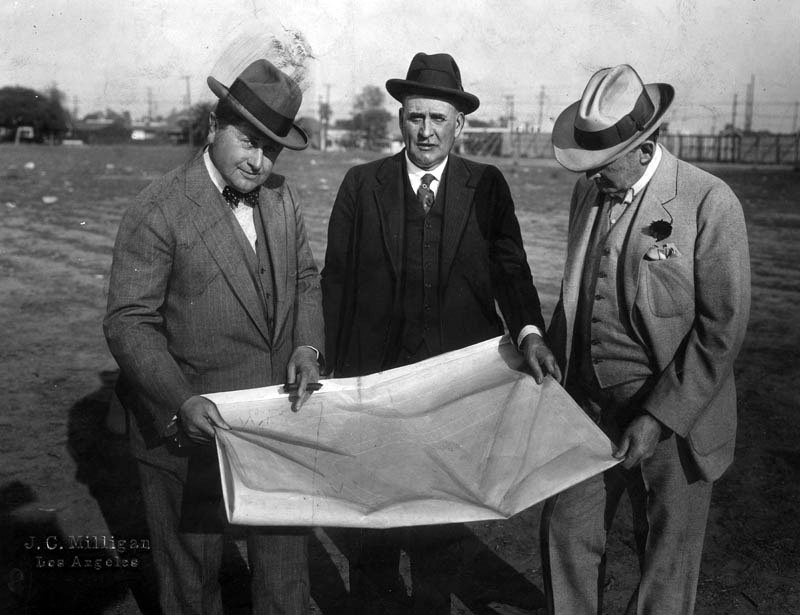 |
|
| (ca. 1924)* - William Wrigley Jr. (left) and partners look over blue prints for Wrigley Field. The chewing-gun magnate bought the Angels in 1921 for $150,000, as a farm team for his Chicago Cubs. Erected in 1925 at 42nd Place and Avalon Blvd., Wrigley Field was a 21,000-seat, home-run hitters paradise. It also doubled as the set for such films as "Pride of the Yankees" and "Alibi Ike" and the "Home Run Derby" television show. |
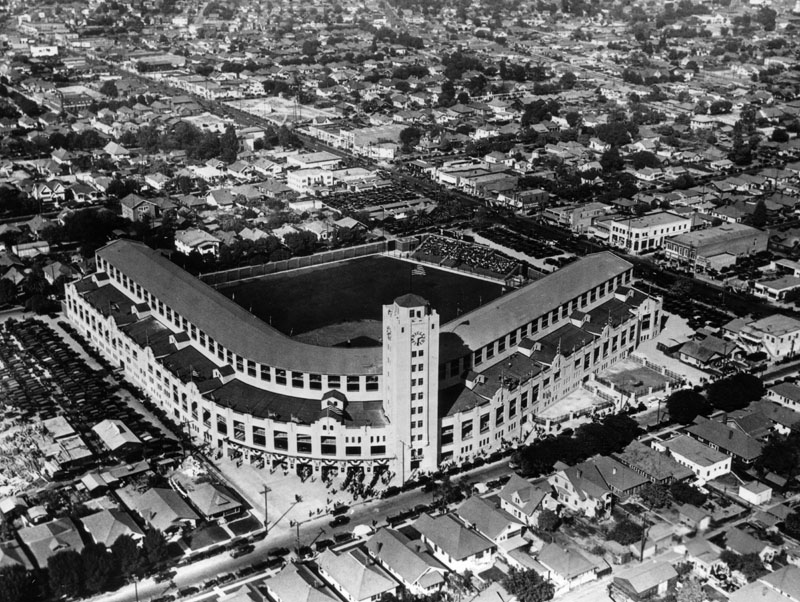 |
|
| (1925)* - Aerial view of Wrigley Field, Opening Day, 1925. |
Historical Background Wrigley Field, built on 10 acres of land in South Los Angeles between San Pedro Street (on the west), Avalon Blvd (to the east), E. 41st Place (to the north), and E. 42 Place (to the south), served as host to minor league baseball teams in the region for over 30 years, and was the home park for the Los Angeles Angels of the Pacific Coast League. Chewing gum magnate, William Wrigley, Jr. purchased the Angels in 1921 for the (then) astronomical sum of $150,000 and then built a stadium for the team a few years later. Construction for Wrigley Field began in 1924 and the 21,000-seat, million-dollar stadium opened on September 29, 1925.* |
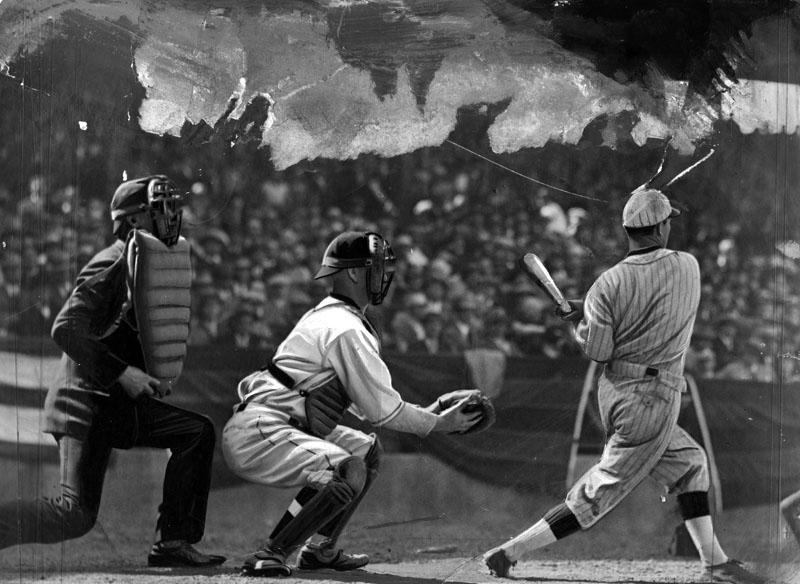 |
|
| (1930)* - The pennant chase is on. The Pacific Coast League gets down to serious business as Angels play at Wrigley Field. Photo dated: April 9, 1930. |
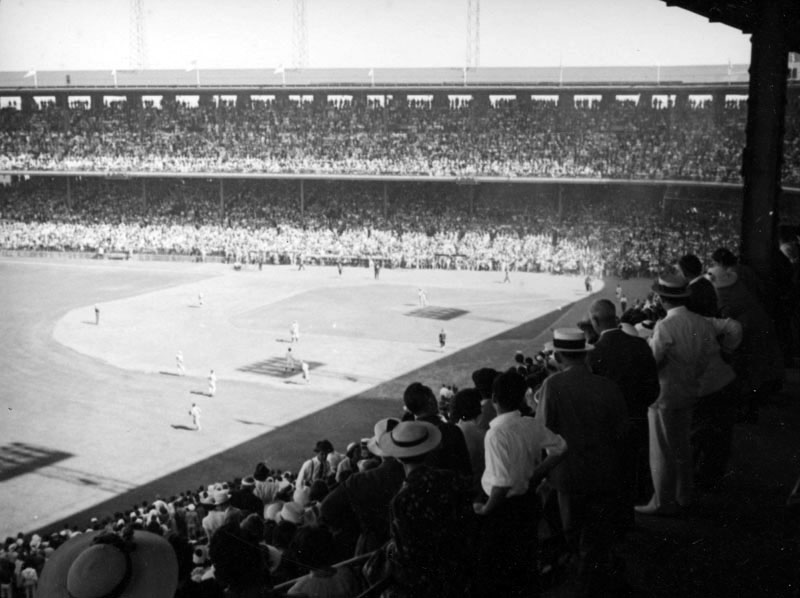 |
|
| (Early 1930s)* - Partial view of the "first" Wrigley Field - home for the Los Angeles Angels of the Pacific Coast League. The bleachers are practically bursting at the seams with eager spectators cheering on their favorite teams. It is unknown which team is out on the field but may be either the Los Angeles Angels, or the other home team, the Hollywood Stars. |
Historical Notes For 33 seasons (1925-1957) the park was home to the Angels, and for 11 of those seasons (1926-1935 and 1938) it had a second home team in the rival Hollywood Stars. The Stars eventually moved to their own new ballpark, Gilmore Field. Prior to 1925, the Angels played at their former home at Washington Park, and before that, at Chutes Park.* |
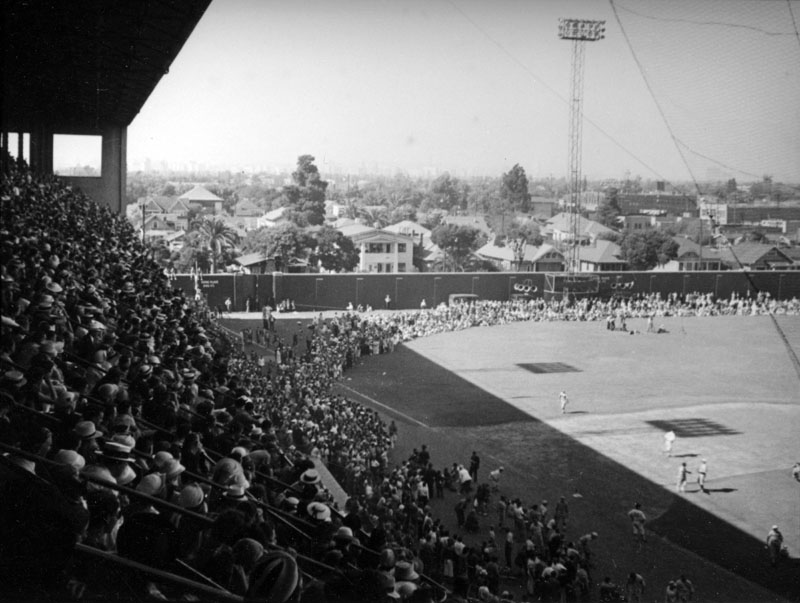 |
|
| (Early 1930s)* - Partial view of the "first" Wrigley Field. The double-decked grandstand extended from the left field foul pole to home plate, and around to the right field foul pole. Bleachers and a scoreboard were located in right field. There was no seating in left field, just a 15-foot-high concrete wall (seen here), though it offered little to no protection for the houses located directly behind it, as they were constantly getting pelted with flying homeruns. |
Historical Notes In February 1957, Phil Wrigley (heir son of William Wrigley), sold both the team and Wrigley Field to Walter O'Malley, owner of the Brooklyn Dodgers, for $3,000,000. The last Pacific Coast League game at Wrigley Field was played on September 15, 1957.* |
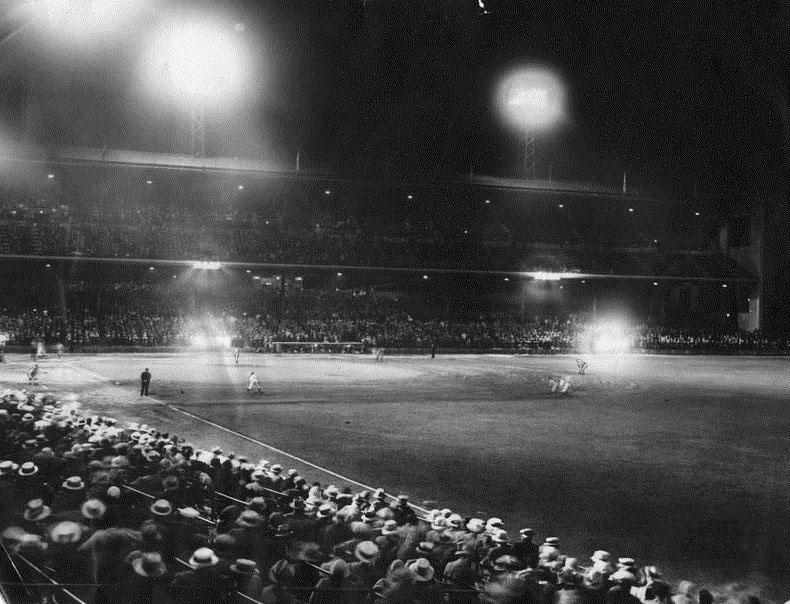 |
|
| (1930)* - The first night game in Los Angeles, at Wrigley Field. Chicago's Wrigley Field wouldn't get lights until 1988. Photo dated: July 22, 1930. |
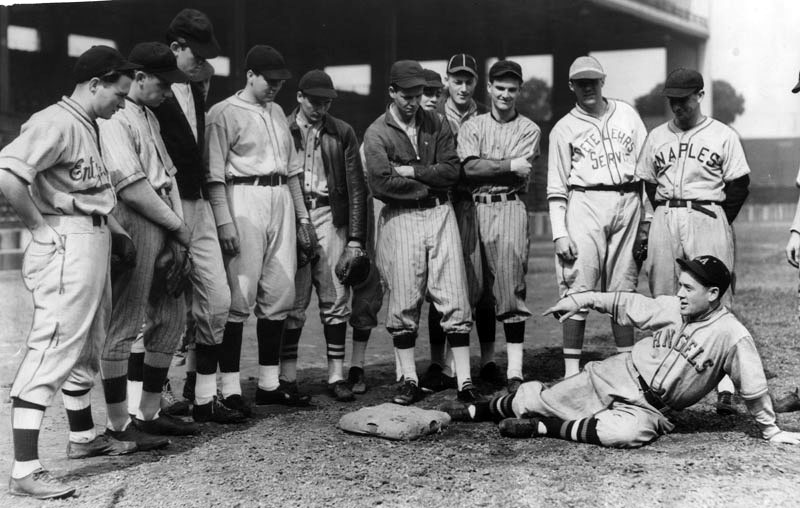 |
|
| (ca. 1935)* - The Angels won 14 PCL pennants, but their best team was the 1934 powerhouse (137-50), led by Triple Crown winner Frank Demaree and Arnold "Jigger" Statz (demonstrating sliding technique). Dubbed the "Greatest Angel of Them All," Statz was an excellent defensive centerfielder who cut a hole in the palm of his mitt to get a better feel for the ball. Statz played 18 seasons in L.A. and owns most of the PCL records (including games played, hits, and runs). Spanning his entire pro career, Statz compiled the most at-bats in baseball history. |
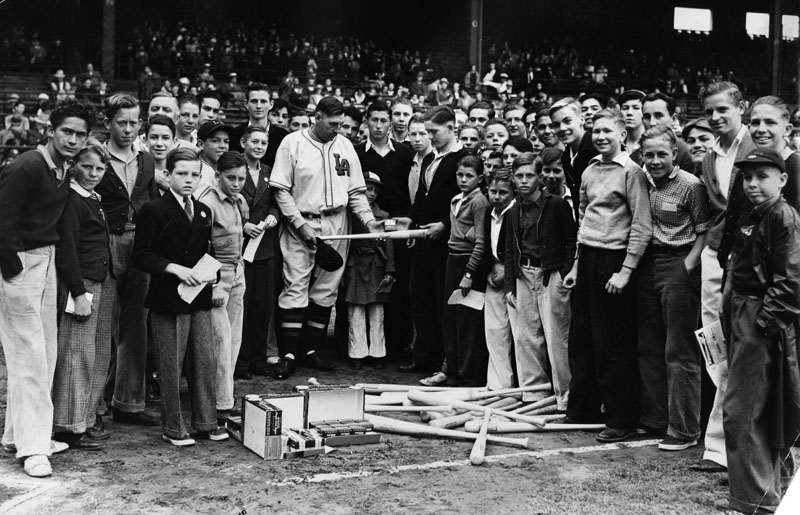 |
|
| (1937)* - Clustered around "Truck" Hannah, manager of the Los Angeles Angels, are a group of 50 excited youngsters who ran off with the prizes in the technical baseball contest staged by The Evening Herald and Express, ready to receive their rewards from the Angel pilot. Some 5000 youngsters were guests of The Evening Herald and Express at Wrigley Field in honor of the 50 prize winners whose knowledge of the game stamped them "Tops." |
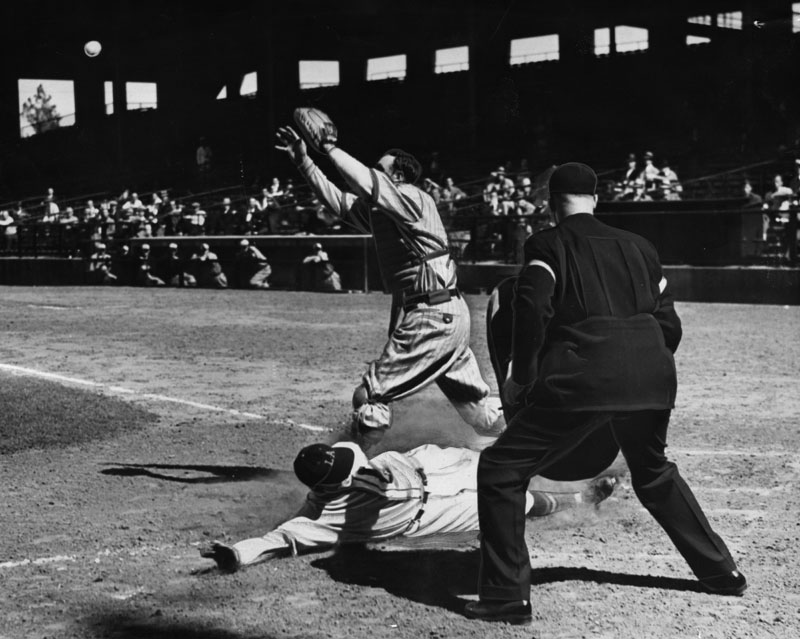 |
|
| (1937)* - "Jigger" Statz slid safely home on an infield hit by Carl Dittmar in the first inning of yesterday's ball game at Wrigley Field, and here the camera catches a wild throw from McDonald to Catcher Wilson of the Portland club. McWilliams also came home on the wild throw. But the Ducks rallied to win the game in the later stages, so the effort went for naught |
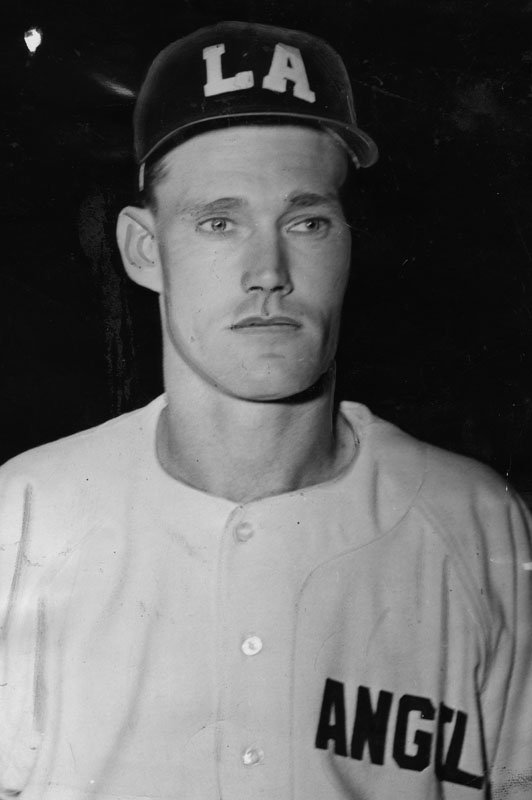 |
|
| (1951)* - Chuck Connors, baseball player for the Angels team. |
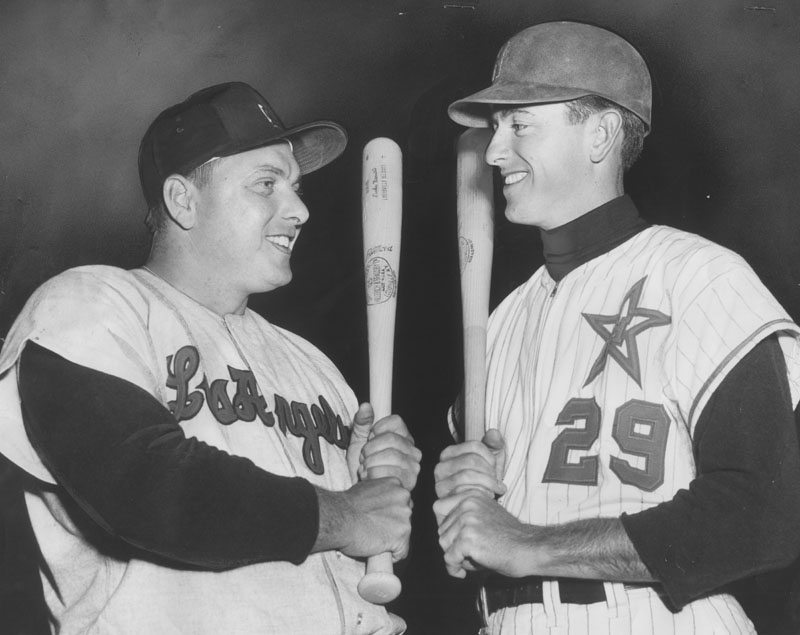 |
|
| (1957)* - Steve Bilko (left), the Angels' greatest power hitter. From 1955-1957, the burly Bilko led the PCL in home runs; he won the Triple Crown in 1956, leading the Angels to the pennant. So popular was Bilko that comedian Phil Silvers named his most famous character, Sergeant Bilko, after the first baseman. "I don't think Bilko talked too much," Herald-Examiner columnist Allan Malamud once said, "but he hit the ball a mile." Dick Stuart (right) the Hollywood Stars' slugging first baseman, was nicknamed "Dr. Strangeglove" for his defensive deficiencies. |
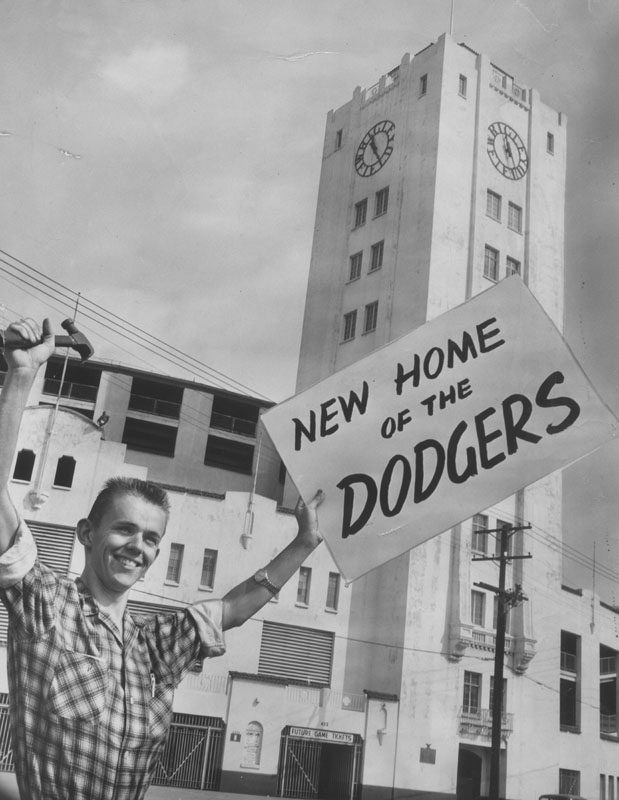 |
|
| (1957)* - In 1957, Walter O'Malley traded his farm team, the Fort Worth Cats, and cash in exchange for the Los Angeles Angels and Wrigley Field, a deal that gave O'Malley territorial rights to L.A. Many fans assumed that he would move the Dodgers to Wrigley Field--home of the Angels--and architects drew up plans to boost seating capacity at the aged stadium. Instead, O'Malley decided to begin play in the renovated Coliseum. |
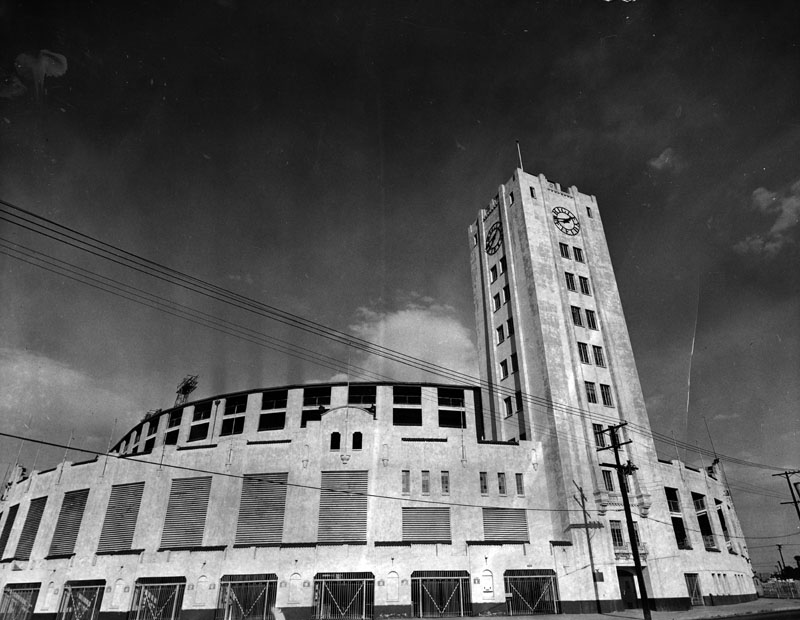 |
|
| (1960)* - Photograph caption dated December 8, 1960 reads, "Here's an exterior shot of Wrigley Field which will house the new Angel baseball team of the American League when it makes its local debut next year. The park, which has a present capacity of 22,500, may be expanded slightly. It is now city-owned, with 340 feet deep left field, 339 feet in right, and 412 feet deep in center. 'It's in good condition,' said officials." |
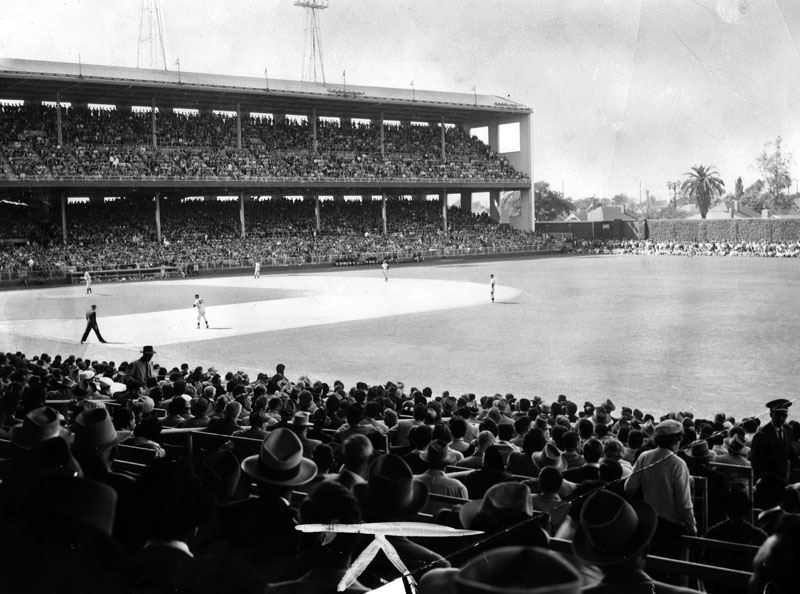 |
|
| (1955)* - Photograph caption dated April 6, 1986 reads, "Wrigley Field no longer exists at 42nd and Avalon, but the L.A. Angels played their first home game there in 1961." |
Historical Notes In 1961, the Los Angeles Angels joined the American League as an expansion team and took residence at Wrigley Field for just one season. The Angels then moved into Dodger Stadium with the Los Angeles Dodgers, until 1965. In 1966, the Angels moved into their own home, Anaheim Stadium. Sadly, with no minor league baseball teams left in the area, Wrigley Field was torn down in the mid 1960s; Gilbert Lindsay Park presently occupies the site.* |
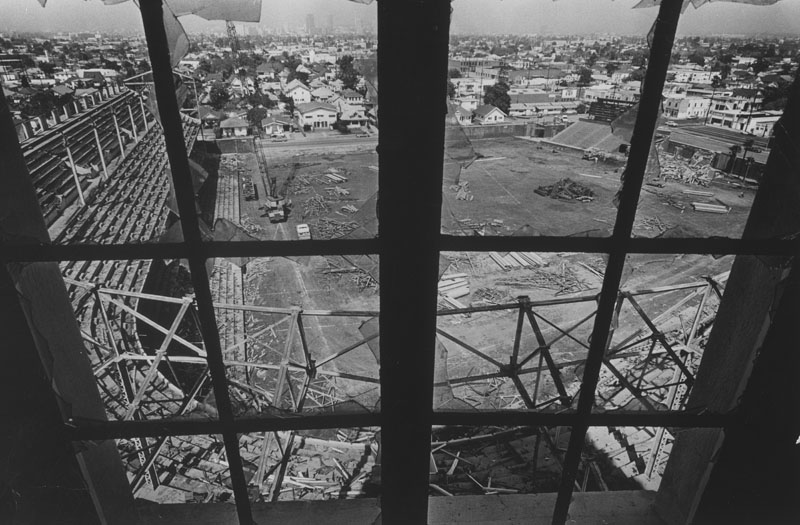 |
|
| (1966)* - Demolition of Wrigley Field. Photo dated: March 19, 1966. |
* * * * * |
Gilmore Field
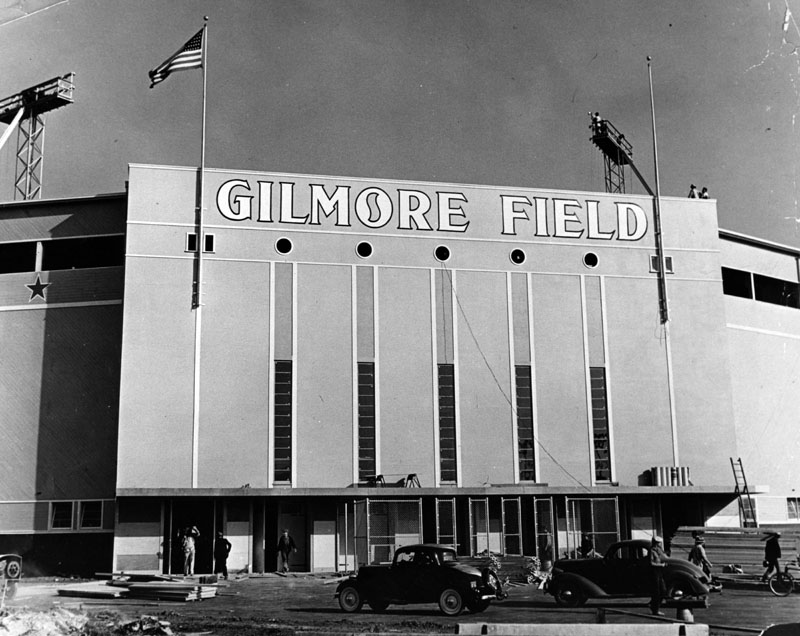 |
|
| (1939)* - Exterior view of the new Gilmore Field (Hollywood Ball Park). |
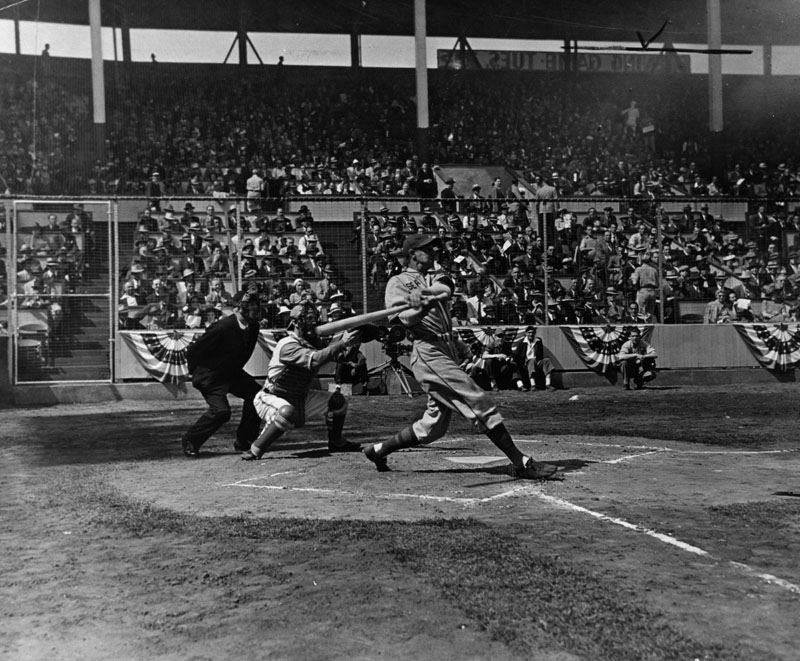 |
|
| (1939)* - Baseball went Hollywood today as the Stars opened their new park, Gilmore Field, before 10,000 fans and movie celebrities. Shown is Jo-Jo White, Seattle's outfielder as he flies out. Doc Crandall is the Stars' catcher. Photo dated: May 2, 1939. |
 |
|
| (ca. 1939)* - Partial view of one side of Gilmore Field and Hollywood Ball Park reveals a small crowd on the left watching Coast League baseball. The team playing the Hollywood Stars is unidentified. |
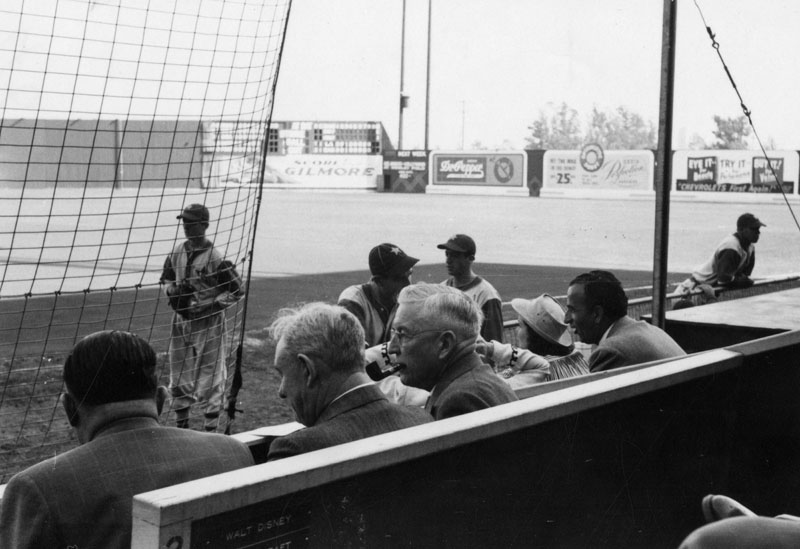 |
|
| (ca. 1940)* - Spectators are seen watching a baseball game in progress at Gilmore Field and Hollywood Ball Park, home of the Hollywood Stars team. The visiting team playing the Stars is unidentified. In the foreground behind the benches, name plaques read, "Walt Disney" and "George Raft", who must have been Stars fans. |
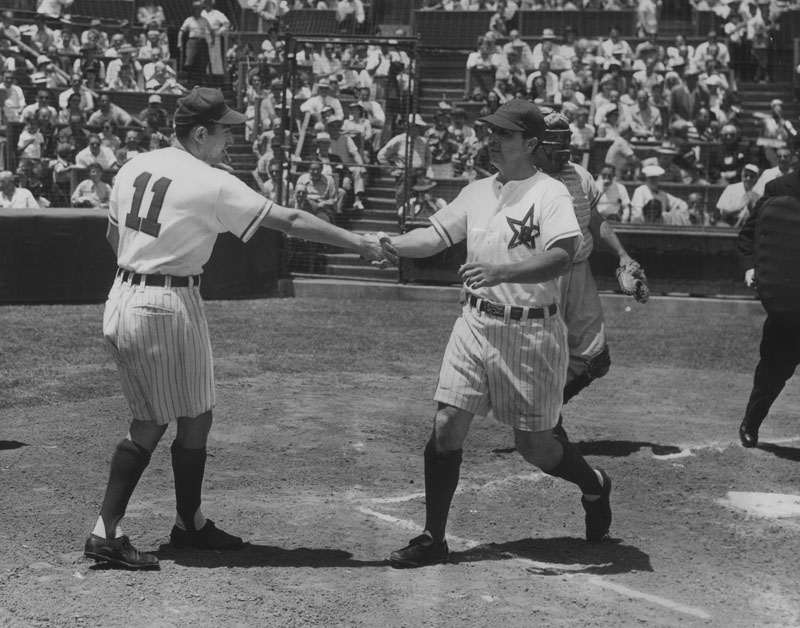 |
|
| (1950)* - After Bill Lane moved the Stars to San Diego, another Hollywood team was born in 1938. Owned by Brown Derby restaurateur Bob Cobb and several movie personalities, the Stars moved from Wrigley into intimate Gilmore Field, near the site of the Farmer's Market, in 1939. Here, after hitting a home run, Frank Kelleher gets a congratulatory handshake from Herb Gorman. The stylish but impractical shorts lasted only a few seasons. |
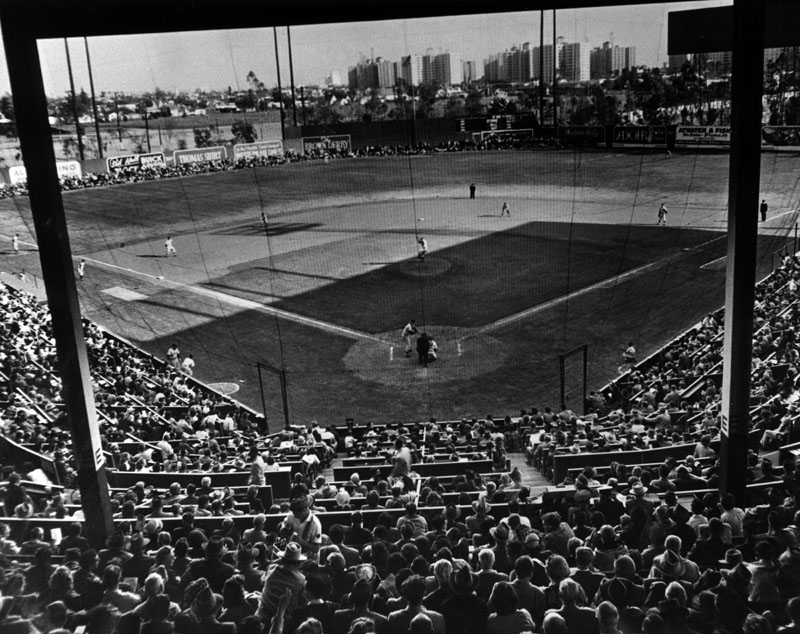 |
|
| (1951)* - Major league All-Stars managed by Ty Cobb and Tris Speaker clashed at Gilmore Field, with the big-leaguers beating the Hollywood Stars, 4-3, for charity. Fans thrilled to Gus Zernial's two homers. |
* * * * * |
Coliseum (Baseball)
 |
|
| (1958)* - The team rides in a motorcade parade down Broadway, en route to its first game in Los Angeles: a 6-5 win over the San Francisco Giants before 78,672 fans at the Coliseum. Despite their inept play and seventh-place finish, the Dodgers drew a record 1,845,556 fans in their first year in Los Angeles. |
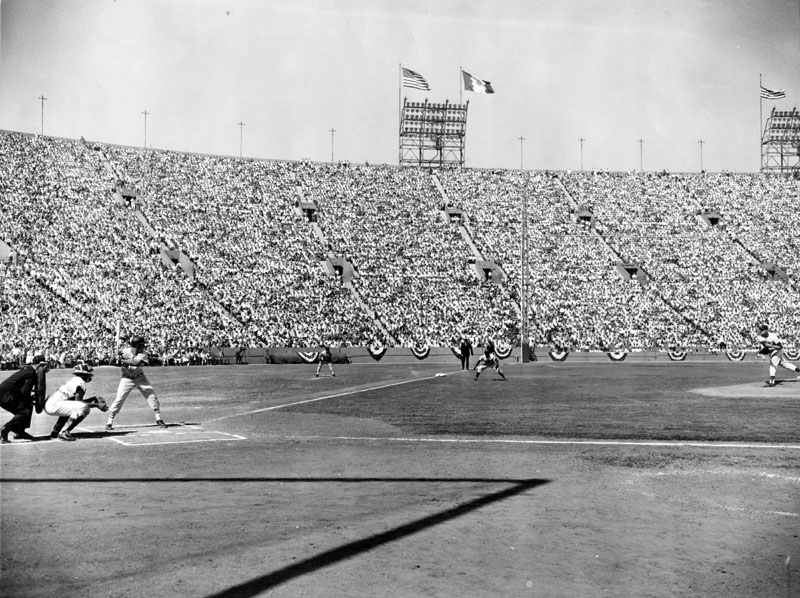 |
|
| (1959)* - Crowds have packed the Coliseum to watch a Dodger game. From 1958 to 1961, the Dodgers played at this stadium. |
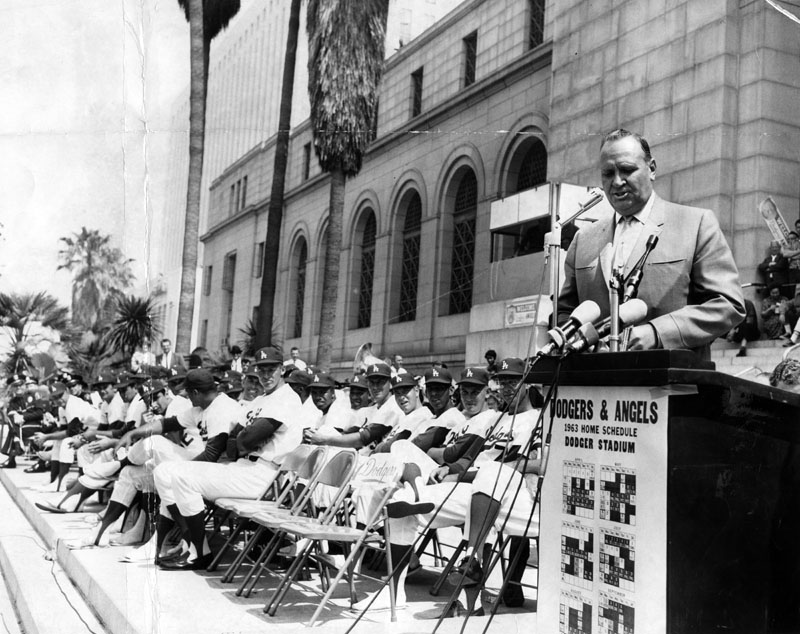 |
|
| (1963)* - Photograph caption dated April 6, 1963 reads, "Gene Autry, co-owner of the Angels, speaks a few words at City Hall ceremonies for the Angels and Dodgers." |
* * * * * |
Dodger Stadium
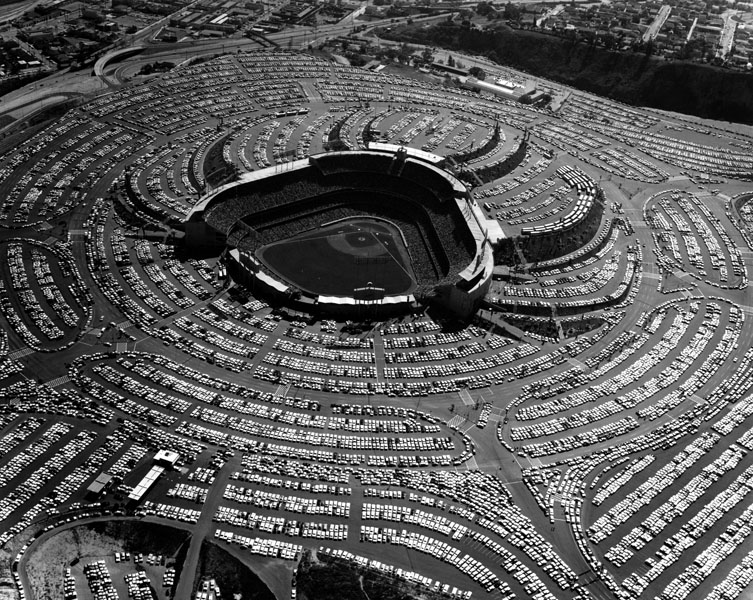 |
|
| (n.d.)* - Aerial view of Dodger Stadium and parking lot filled with parked cars. |
Historical Notes Dodger Stadium has been the home ballpark of Major League Baseball's Los Angeles Dodgers team since 1962. It constructed from 1959 to 1962 at a cost of $23 million ($177 million in 2012 dollars) and financed by private sources.*^ |
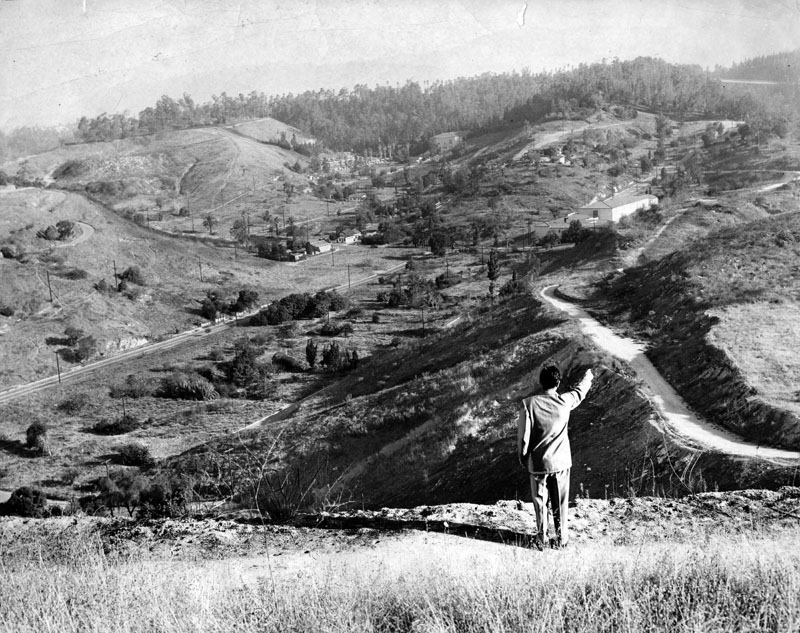 |
|
| (1957)* - On October 7, 1957, Walter O'Malley announced that he was moving the Dodgers west and that he would build a new stadium on land in Chavez Ravine. Here, a man points out the future location of home plate. The police academy can be seen in the far background. |
Historical Notes In the mid-1950s, Brooklyn Dodger team president Walter O'Malley had tried to build a domed stadium in the New York City borough of Brooklyn, but was unable to reach an agreement with city officials land acquisition, and eventually reached a deal with the city of Los Angeles. The land for Dodger Stadium was purchased from local owners and inhabitants in the early 1950s by the city of Los Angeles using eminent domain with funds from the Federal Housing Act of 1949. The city had planned to develop the Elysian Park Heights public housing project, which included two dozen 13-story buildings and more than 160 two-story townhouses, in addition to newly rebuilt playgrounds and schools. Before construction could begin on the housing project, the local political climate changed greatly when Norris Poulson was elected mayor of Los Angeles in 1953. By then, the proposed public housing projects like Elysian Park Heights lost most of their support. Following protracted negotiations, the city purchased the Chavez Ravine property back from the Federal Housing Authority at a drastically reduced price, with the stipulation that the land be used for a public purpose. It was not until June 3, 1958, when Los Angeles voters approved a "Taxpayers Committee for Yes on Baseball" referendum, that the Dodgers were able to acquire 352 acres of Chavez Ravine from the city.*^ |
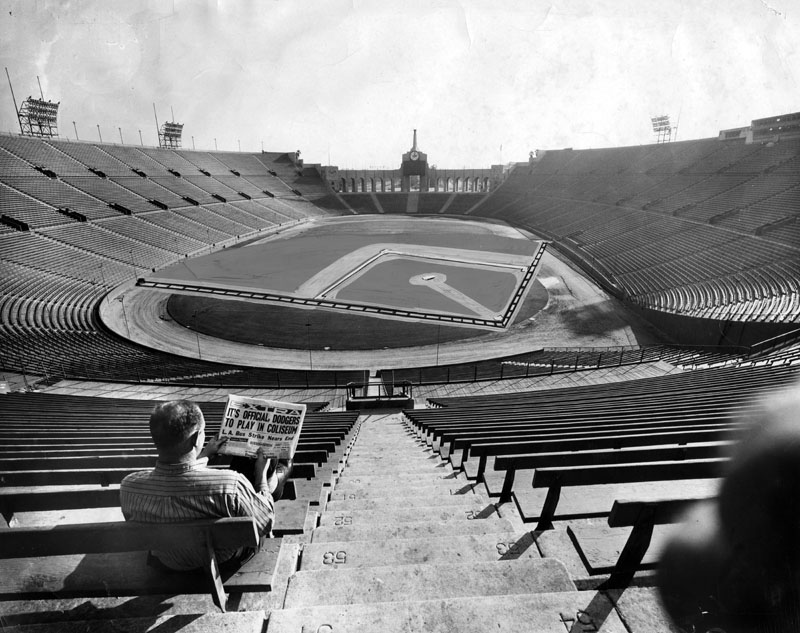 |
|
| (1958)* - View of the Los Angeles Memorial Coliseum where a man is sitting in the 53rd row. The headline of the newspaper that he is holding says, "It's official, Dodgers to play in Coliseum." Photograph caption reads: "Here's Dodger fan's perspective of Coliseum diamond from 53rd row. Dotted lines indicate foul lines on field where Dodgers open season here against Giants April 18." |
Historical Notes While Dodger Stadium was under construction, the Dodgers played in the league's largest capacity venue from 1958 through 1961 at their temporary home, the Los Angeles Memorial Coliseum, which could seat in excess of 90,000 people.*^ |
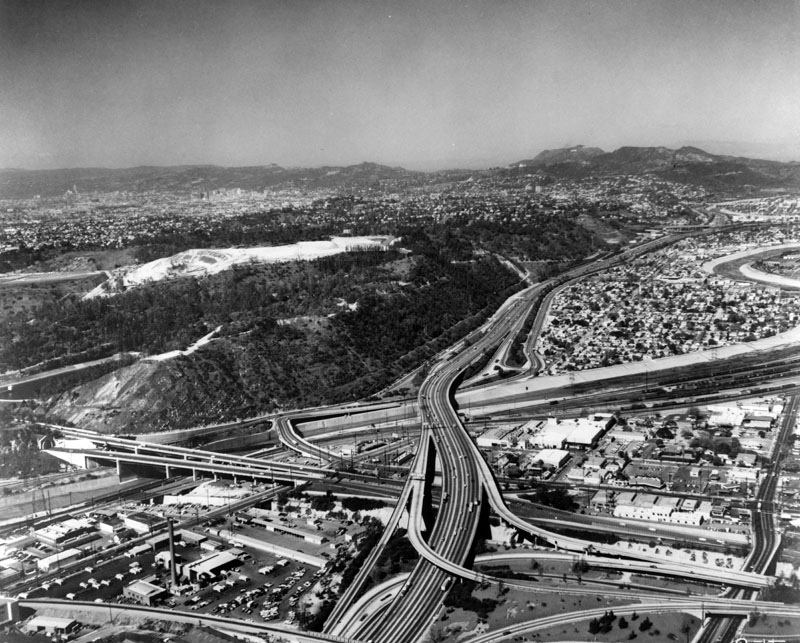 |
|
| (ca. 1960)* - Aerial view of Chávez Ravine (hill on the left) and Dodger Stadium under construction, as well as the numerous freeway "veins" that run through the city of Los Angeles. Hundreds of homes are also visible in the surrounding areas as far as the eye can see. |
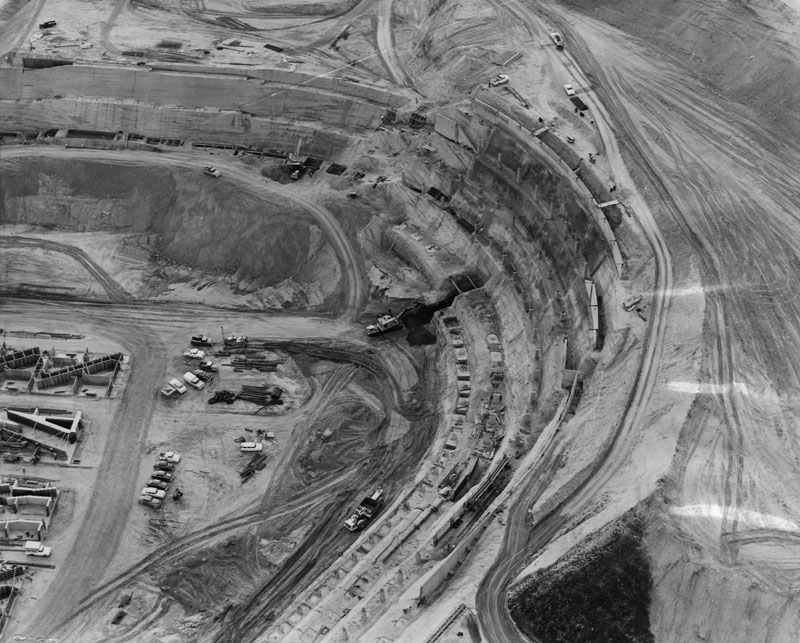 |
|
| (1961)* - Photograph caption dated February 16, 1961 reads, "Dirt tiers will soon support stands for 56,200-seat Dodger Bowl for 1962." |
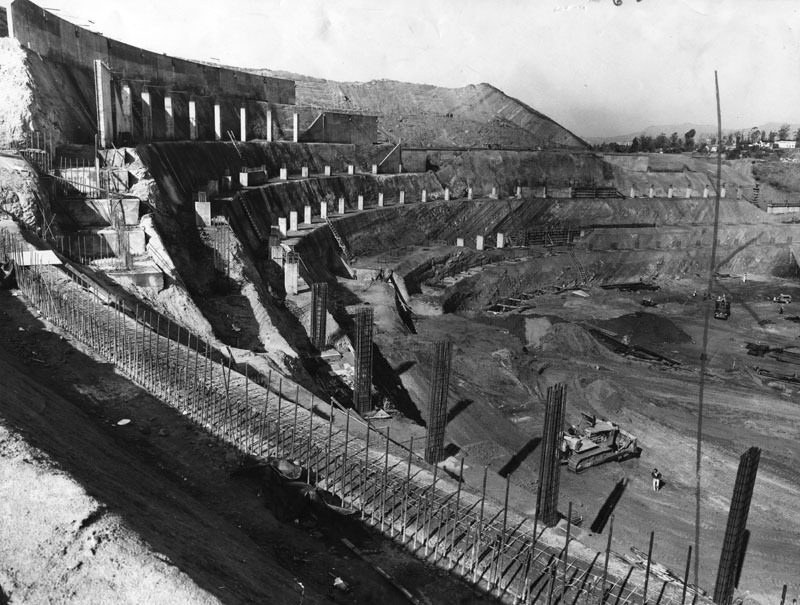 |
|
| (1961)* - Photograph caption reads, "Work ahead of schedule in Chavez Ravine." |
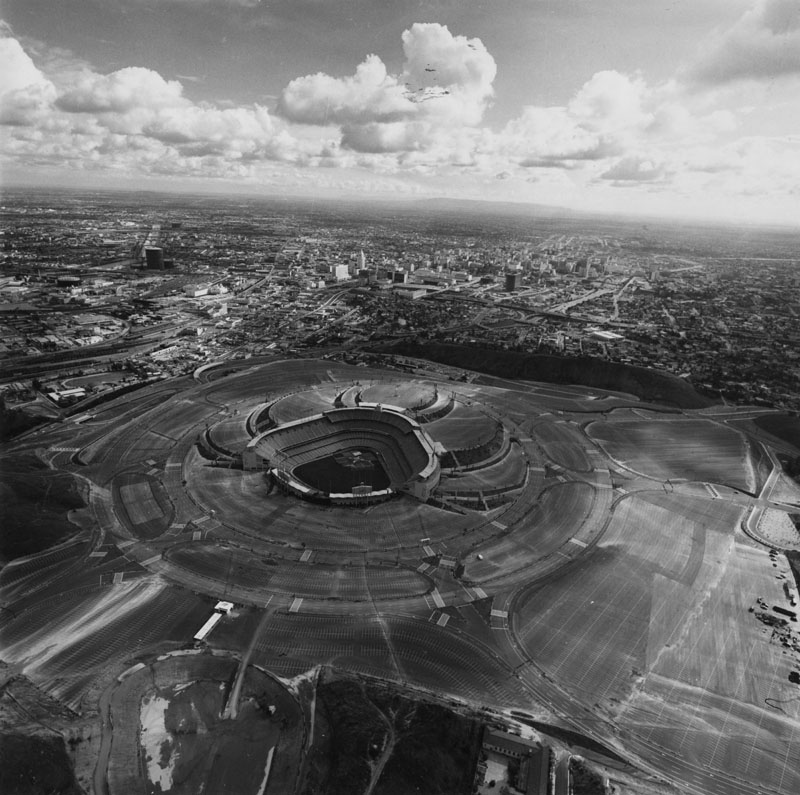 |
|
| (ca. 1961)* - Aerial view of downtown Los Angeles, showing Dodger Stadium during the final stages of its construction in the foreground. |
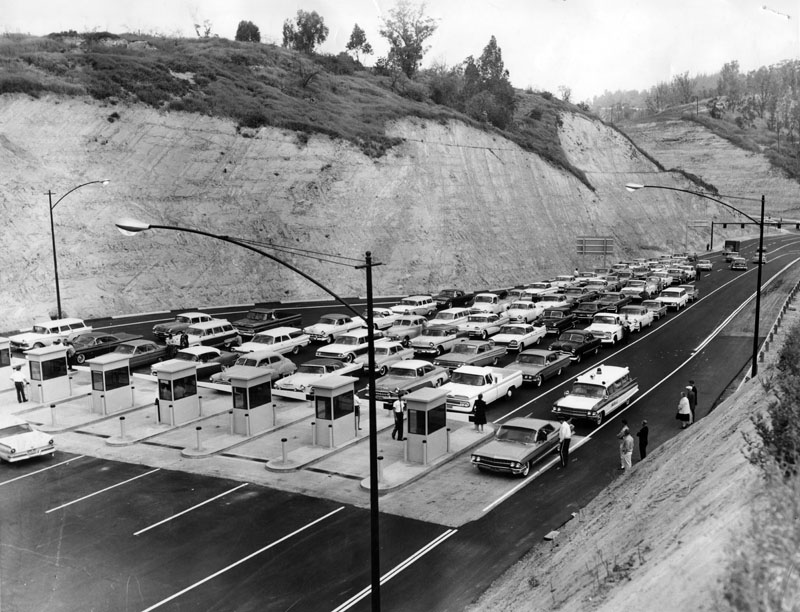 |
|
| (1962)* - Photograph caption dated April 10, 1962 reads, "No, this isn't an on-ramp to a toll road. Nor is it a traffic jam. It's an auto lineup of anxious baseball fans waiting at Solano Street entrance to new Dodger Stadium today. Note ambulance waiting in extreme right lane of photo. Solano entrance is one of five access roads busy early today routing 56,000 fans making beeline to Dodger opener in $18 million stadium." |
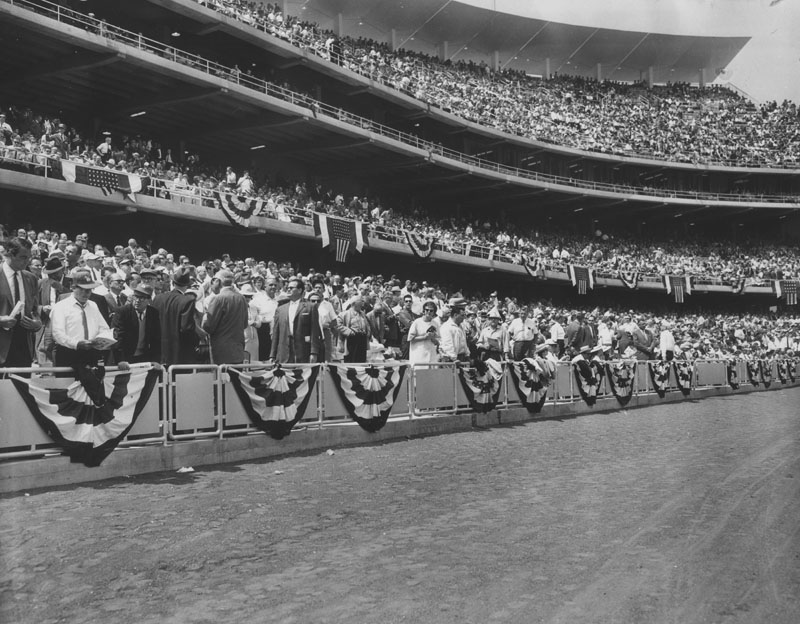 |
|
| (1962)* - Opening Day: April 10, 1962. Fans lined up to see the new ballpark, then awaited the first pitch. The Dodgers lost, 6-3, to the Cincinnati Reds, the defending National League champs, before 52,564 fans. That year, the Dodgers drew 2.7 million fans, the most in baseball history to that point. |
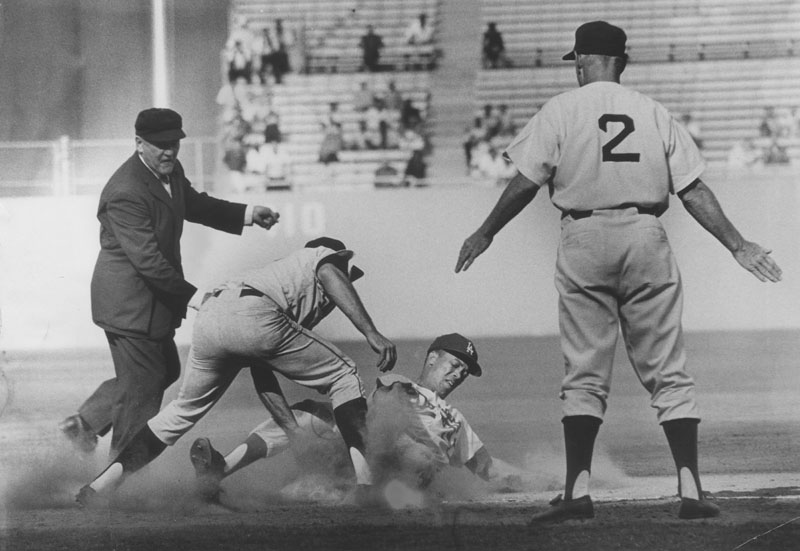 |
|
| (1962)* - During the Dodgers' first years in L.A., shortstop Maury Wills sparked the team's meager offense. Wills led the National League in stolen bases from 1960-1966, and shattered Ty Cobb's 47-year-old record of 97 stolen bases by swiping 104 in 1962. Despite the fact that L.A. lost its lead over the rival Giants in the 1962 pennant race, Wills won MVP. |
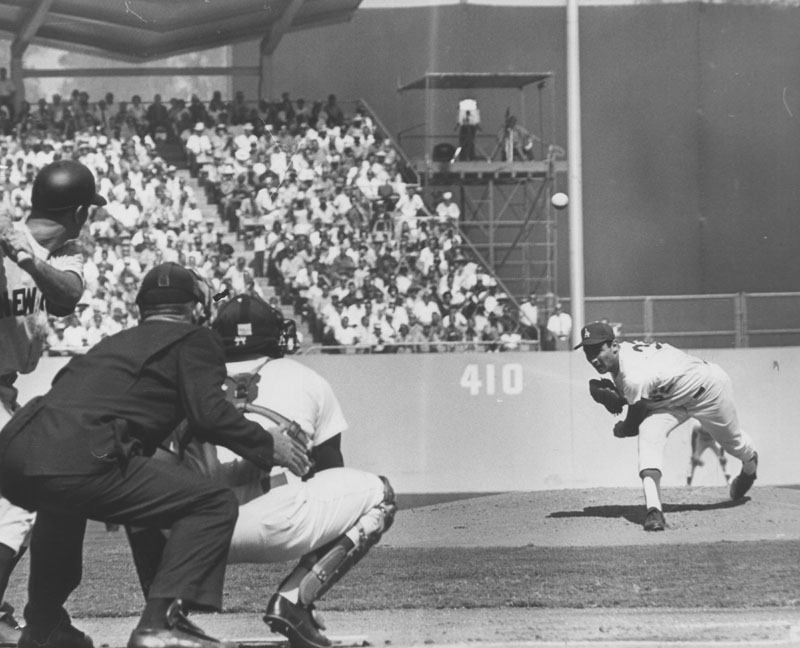 |
|
| (1963)* - Like Drysdale, Sandy Koufax began his career in Brooklyn. Like Drysdale, he came into his own in L.A. And, like Drysdale, he retired because of an arm injury. Beginning in 1961, Koufax won 25 or more games three times and led L.A. to three World Series titles. One of the few elite Jewish athletes, he refused to pitch the opening game of the 1965 World Series because it fell on Yom Kippur. With the Series tied at 3-3, Koufax pitched the seventh and deciding game on two days rest--and beat the Minnesota Twins, 2-0. The "Left Hand of God," indeed. |
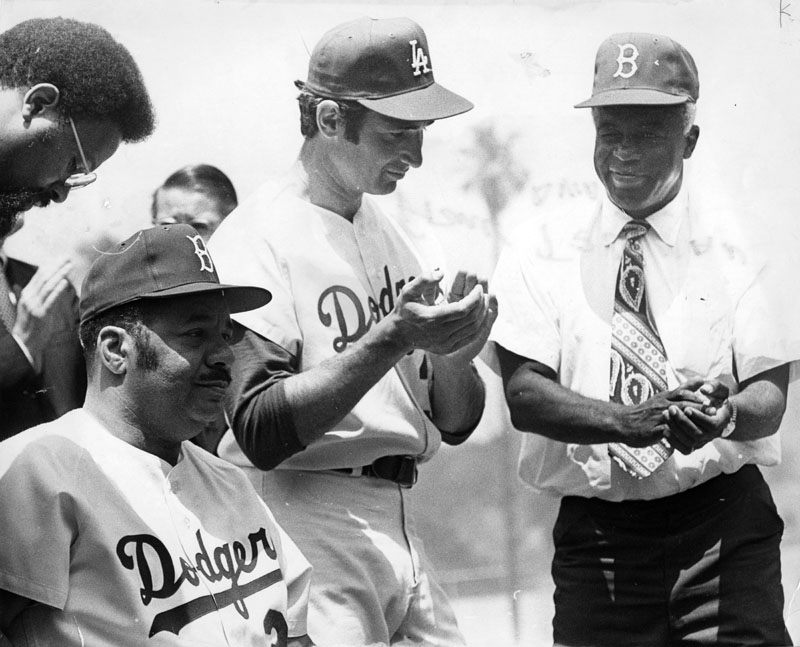 |
|
| (1972)* - Photograph caption reads: "Two stars from Brooklyn flank great one from Los Angeles, as Roy Campanella (left), Sandy Koufax (center) and Jackie Robinson get together." Photograph dated June 5, 1972. |
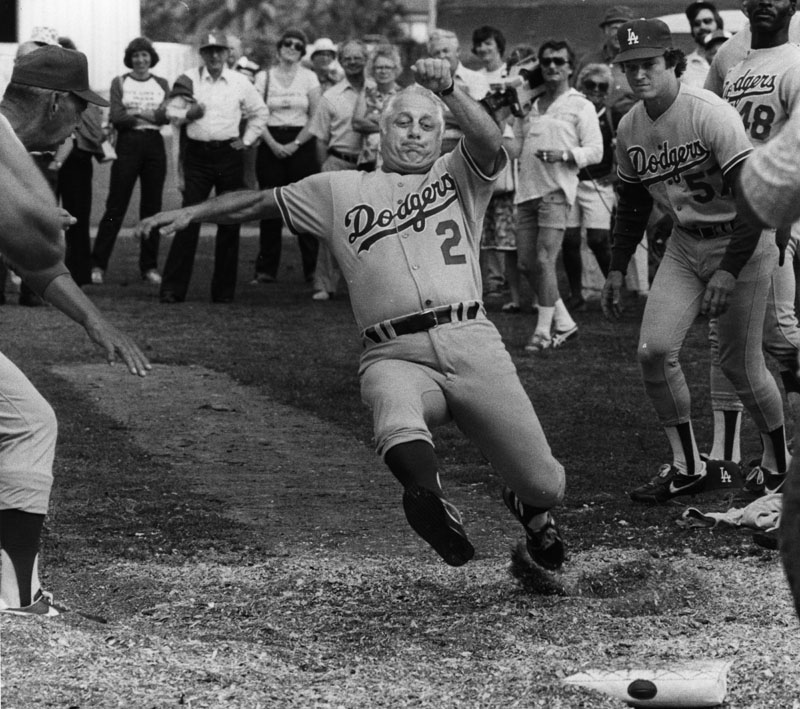 |
|
| (n.d.)* - Dodger players and onlookers in background, watch as Tommy Lasorda slides into base bag. |
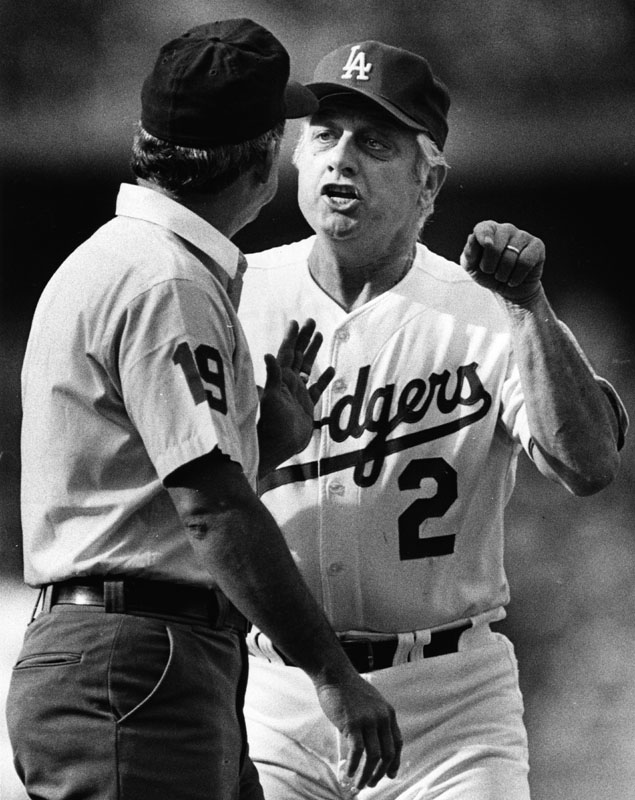 |
|
| (n.d.)* - Dodger manager Tommy Lasorda argues his point with base umpire. |
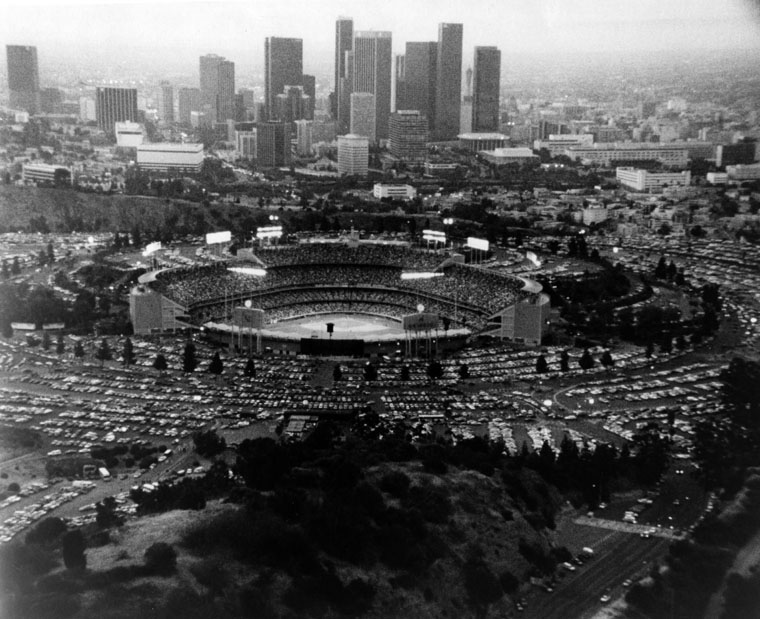 |
|
| (n.d.)* - Aerial view of a packed Dodger Stadium. Rows upon rows of cars are parked around the stadium and crowds of people fill the bleachers. |
Notes Dodger Stadium is currently the third oldest ballpark in Major League Baseball (behind Fenway Park in Boston and Wrigley Field in Chicago) and is the largest ballpark by seating capacity. It has always held 56,000 fans, due to a conditional-use permit limiting its capacity. Every time the Dodgers add seats, they always remove an equal number of seats in the upper deck or in the pavilion to keep the capacity the same.*^ |
* * * * * |
Angel Stadium
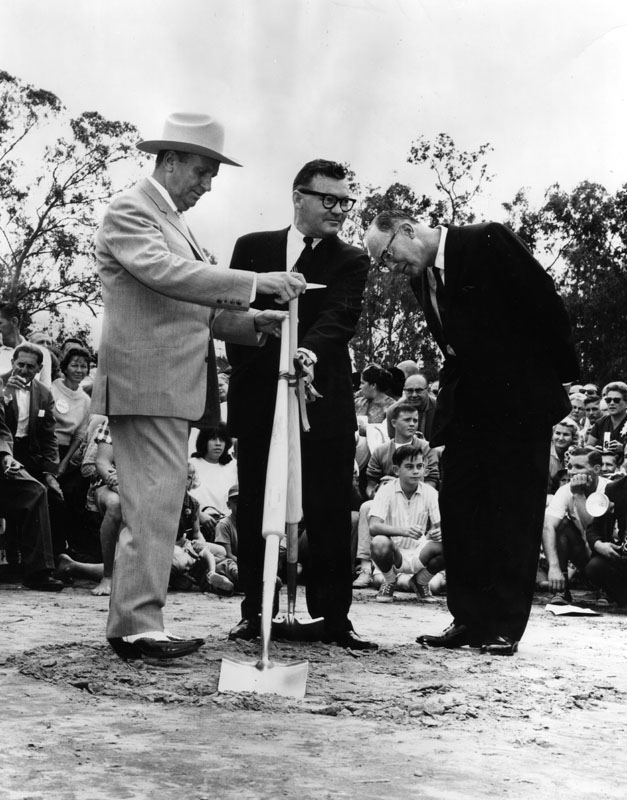 |
|
| (1964)* - The historic groundbreaking for Anaheim Stadium with Angels and City of Anaheim officials and large turnout of fans on hand. Participating in two-shovel ceremonies were, from left, Angels Chairman of the Board, Gene Autry, Anaheim's then Mayor Odra Chandler and Conractor Del Webb. The shovels had baseball bat handles. |
Historical Notes Angel Stadium has been the home of the Angels since their move from Los Angeles. In 1964, ground was broken for Anaheim Stadium and in 1966, the then-California Angels moved into their new home after having spent four seasons renting Dodger Stadium (referred to during Angels games as Chávez Ravine Stadium) from the Dodgers.*^ |
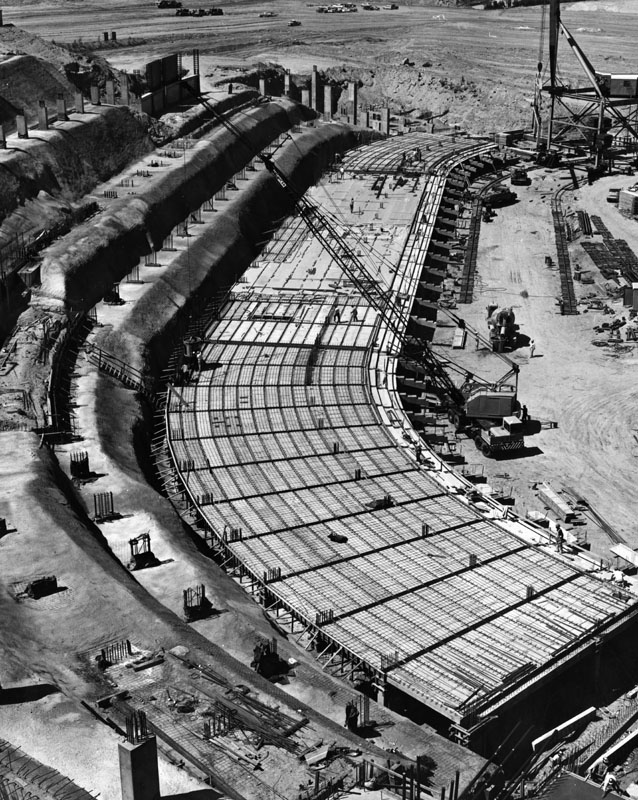 |
|
| (ca. 1965)* - View of a crane at work during the construction of the new Angel Stadium in Anaheim |
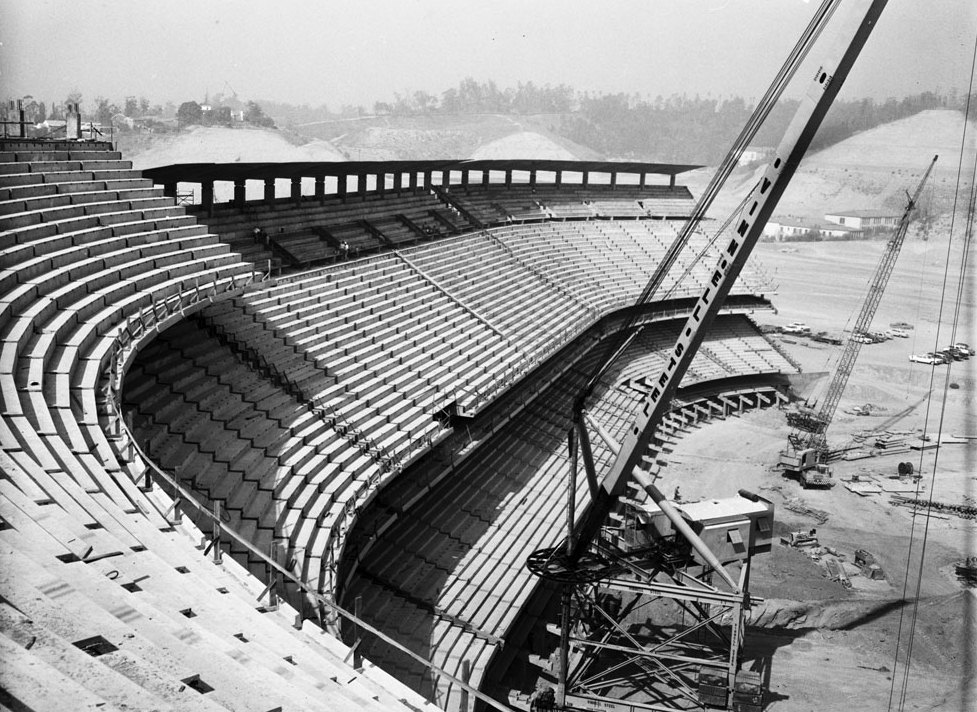 |
|
| (1961)^ - Pan shot of ball park during the construction. |
 |
|
| (ca. 1965)* - Aerial view of the construction of the new Angel Stadium in Anaheim |
 |
|
| (ca. 1966)* - Aerial view of Angel Stadium close to completion. |
Historical Notes The stadium was built on a parcel of about 160 acres of flat land originally used for agricultural purposes in the southeast portion of Anaheim. Consistent with many major-league sports stadiums built in the 1960s, it is located in a suburban area, though one that is host to major tourist attractions.*^ |
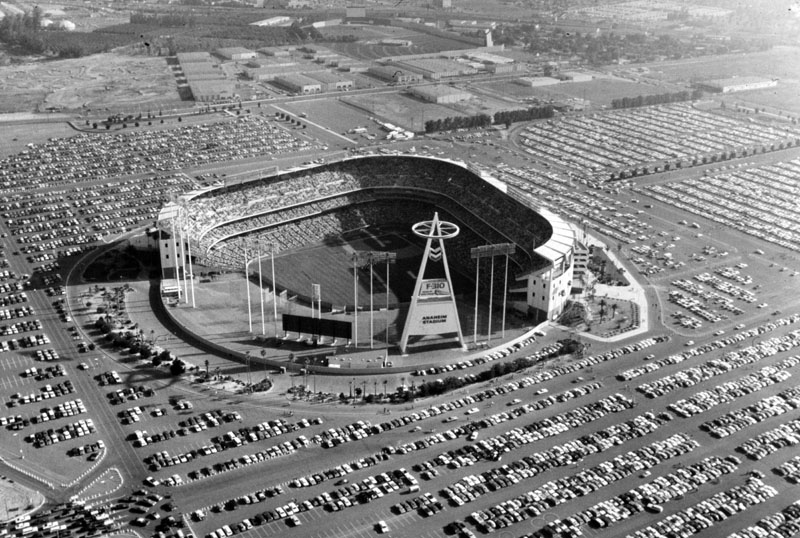 |
|
| 1960s)* - One of the first games to be played at Angels Stadium. |
Historical Notes Angel Stadium, the fourth oldest active Major League Baseball stadium, was selected to host the 2010 Major League Baseball All-Star Game. The stadium also houses the studios and offices of the Angels' owned and operated flagship radio station, KLAA (830 AM).*^ |
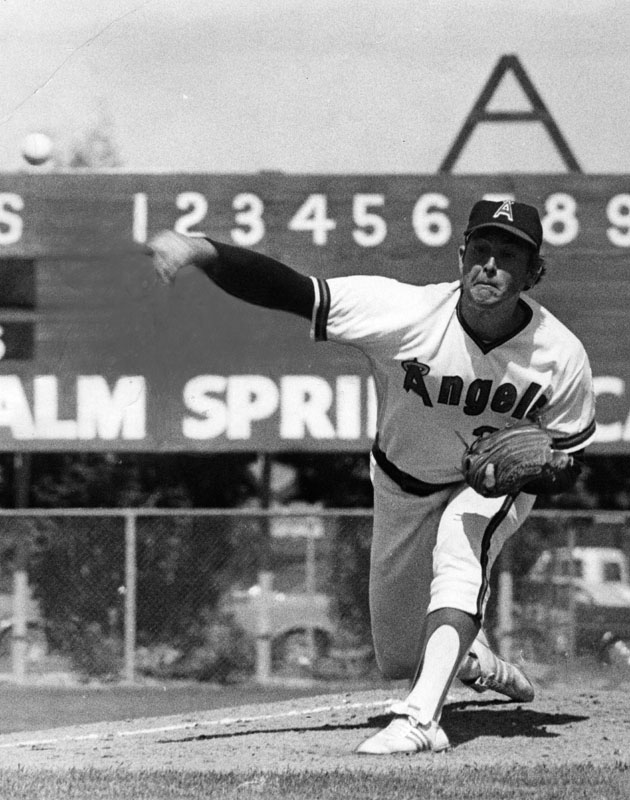 |
|
| (1970s)* - Pitcher Nolan Ryan throws a good one off the mound at Angels camp in Palm Springs. Nolan played on the Angels for eight seasons (1972 - 1979). |
Historical Notes In his first season with the Angels, Ryan, given a chance to pitch regularly as a starter for the first time in his career, had a league-leading 329 strikeouts—nearly a third more than the AL runner-up, and to that point, the fourth-highest total of the 20th century. Within five seasons, the season would only be Ryan's fourth-highest strikeout total. He also set a still-standing Major League record by allowing only 5.26 hits per nine innings, breaking Luis Tiant's 5.30 in 1968, as well as posting a 2.28 earned run average that year, to date the second lowest in franchise history, trailing only Dean Chance's 1.65 in 1964. Though Ryan's actual winning percentage hovered only slightly over .500, his strikeouts and no-hitters brought him media attention. *^ |
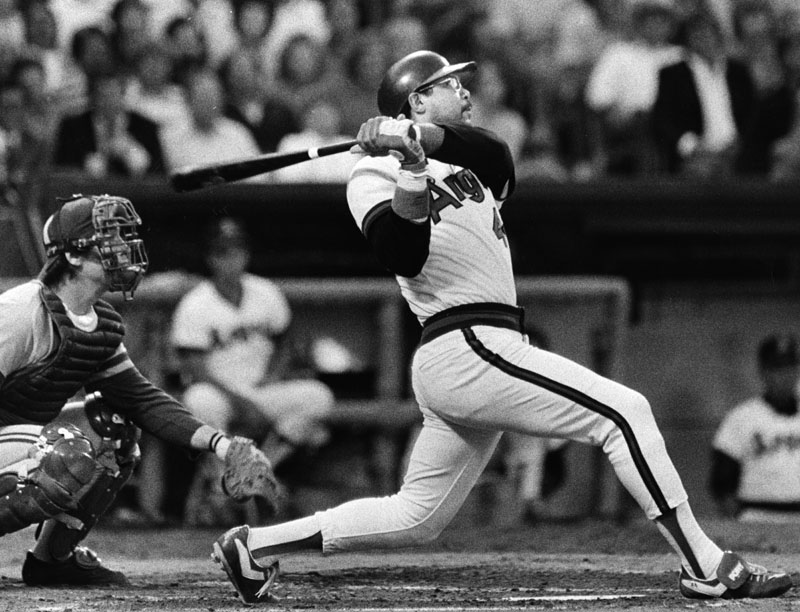 |
|
| (1982)* - This classic Reggie swing produced a classic Reggie home run to dead centerfield. He was a California Angel for 5 seasons (1982 - 1986). |
Historical Notes Reggie Jackson played 21 seasons and reached the post-season in 11 of them, winning six pennants and four World Series. His accomplishments include winning both the regular-season and World Series MVP awards in 1973, hitting 563 career home runs (sixth all-time at the time of his retirement), maintaining a .490 career slugging percentage, being named to 14 All-Star teams, and the dubious distinction of being the all-time leader in strikeouts with 2,597 (he finished with 13 more career strikeouts than hits). Jackson was the first major leaguer to hit one hundred home runs for three different clubs, having hit over 100 for the Athletics, Yankees, and Angels.*^ |
* * * * * |
Early Football
Gilmore Stadium
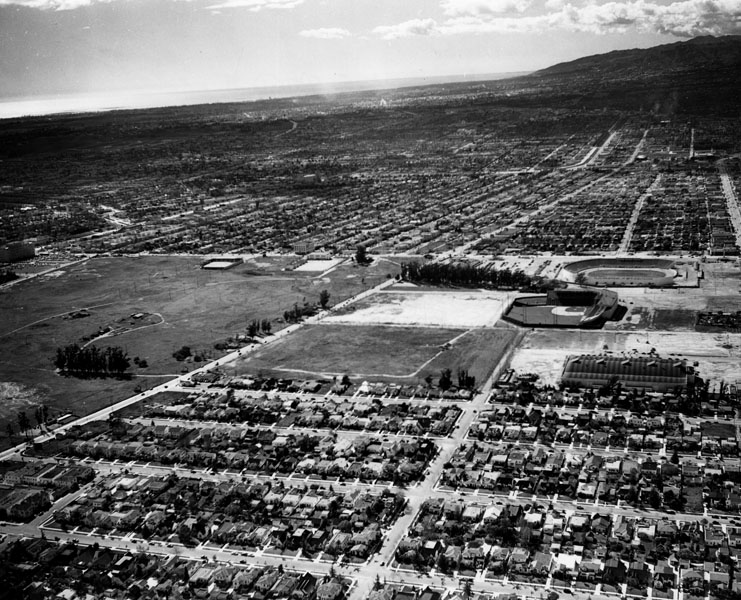 |
|
| (1930s)* - Aerial view of Hollywood Ball Park (Gilmore Field) and Gilmore Stadium, located east of Fairfax Avenue between Beverly Blvd. and 3rd Street. This site later became Farmers Market and later The Grove shopping center, as well as CBS Television City. |
 |
|
| (1934)* - Aerial view of Gilmore Stadium shows a packed crowd in attendance, October 15, 1934. |
Historical Notes Built by Earl Gilmore, Gilmore Stadium opened in May 1934 and was demolished in 1952. The first professional football team in Los Angeles, the Los Angeles Bulldogs played at Gilmore. Before the neighboring Gilmore Field opened in 1939, the Hollywood Stars, a Pacific Coast League baseball team used Gilmore Stadium for their home games. * |
 |
|
| (1947)* - Football at Gilmore Stadium, located near the present-day Farmer's Market in the Fairfax District. The dirt oval surrounding the field was used for auto racing. |
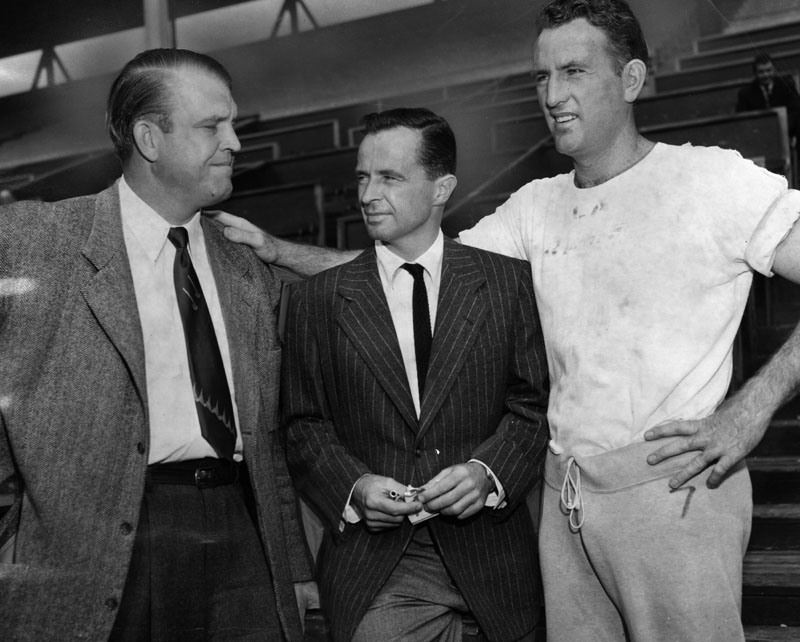 |
|
| (1952)* - Taking over as head coach of the Los Angeles Rams was Hampton Pool, left, pictured here with Co-owner Dan Reeves and Quarterback Bob Waterfield as they practiced at Gilmore Stadium today for their game Friday night with Detroit at the Coliseum. |
 |
|
| (ca.1940)* - Jackie Robinson with (from left) Ned Mathews, Bill Overlin, and Kenny Washington. When Robinson came to UCLA, he teamed with Lincoln High's Washington to form what Herald-Examiner columnist Mel Durslag called "the best backfield twosome of that era." In 1946, the Cleveland Rams moved to L.A. and signed Washington and UCLA teammate Woody Strode, thus breaking the color barrier in the modern era of the NFL. The next year, Robinson made his first appearance with the Brooklyn Dodgers. |
* * * * * |
References
* LA Public Library Image Archive
^ USC Digital Archive
*^Wikipedia: Dodger Stadium; Angels Stadium; Nolan Ryan; Reggie Jackson; Los Angeles Angels (PCL)
< Back
Menu
- Home
- Mission
- Museum
- Mulholland Service Award
- Major Efforts
- Board Officers and Directors
- Positions on Owens Valley and the City of Los Angeles Issues
- Legislative Positions on
Water Issues
- Legislative Positions on
Energy Issues
- Recent Newsletters
- Historical Op Ed Pieces
- Membership
- Contact Us
- Search Index